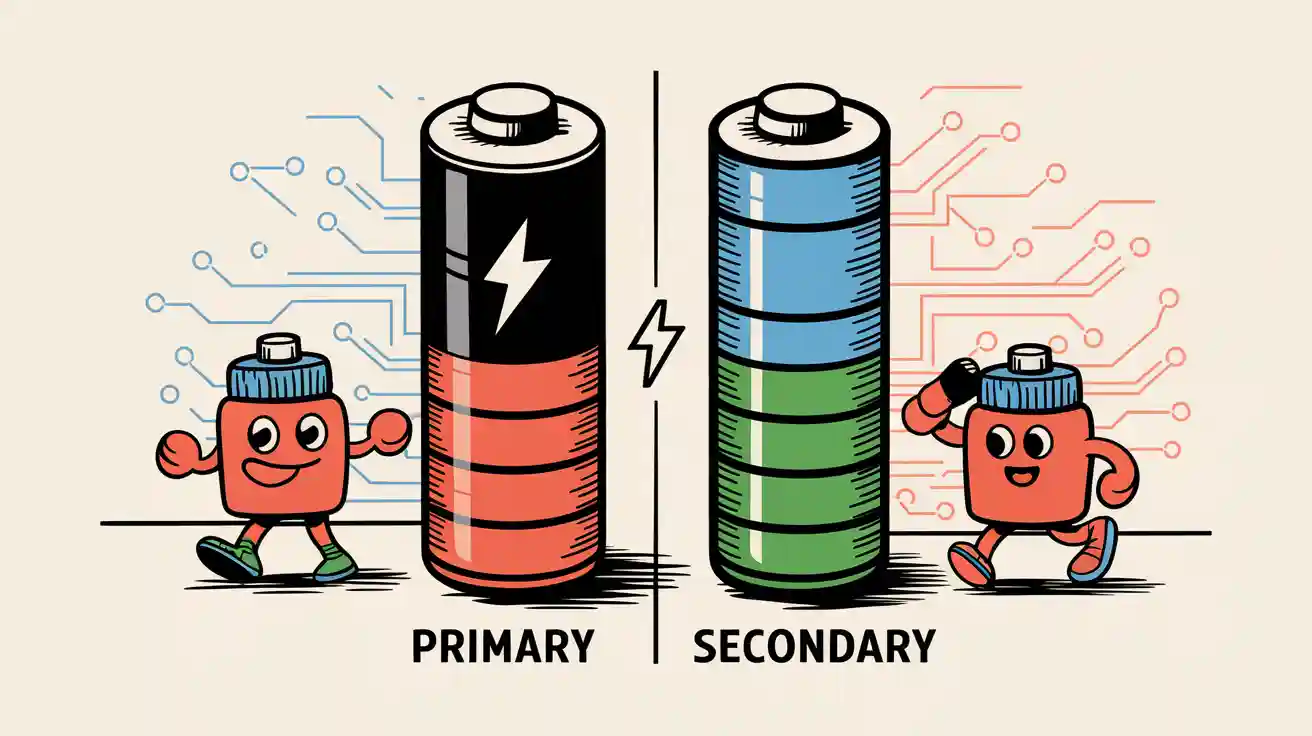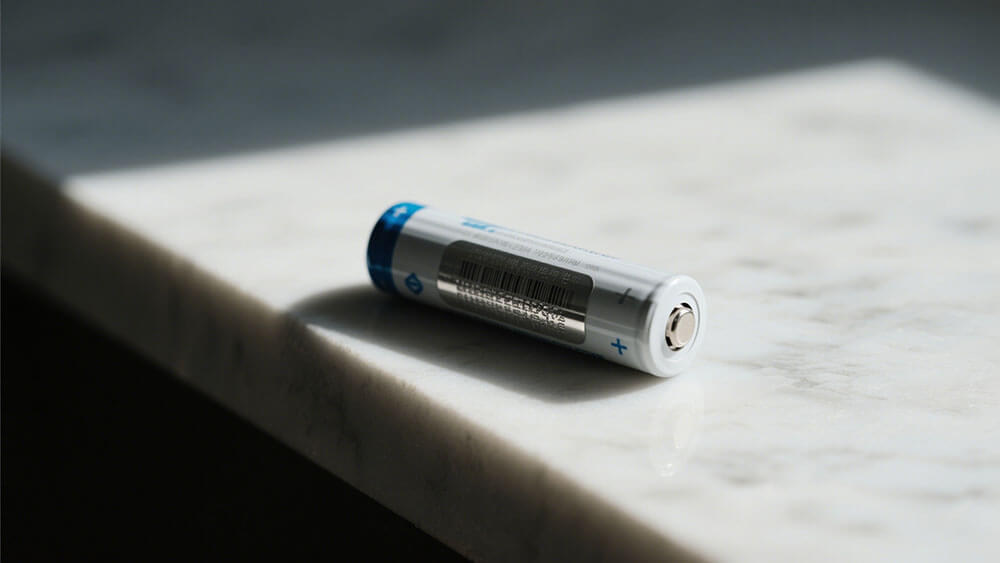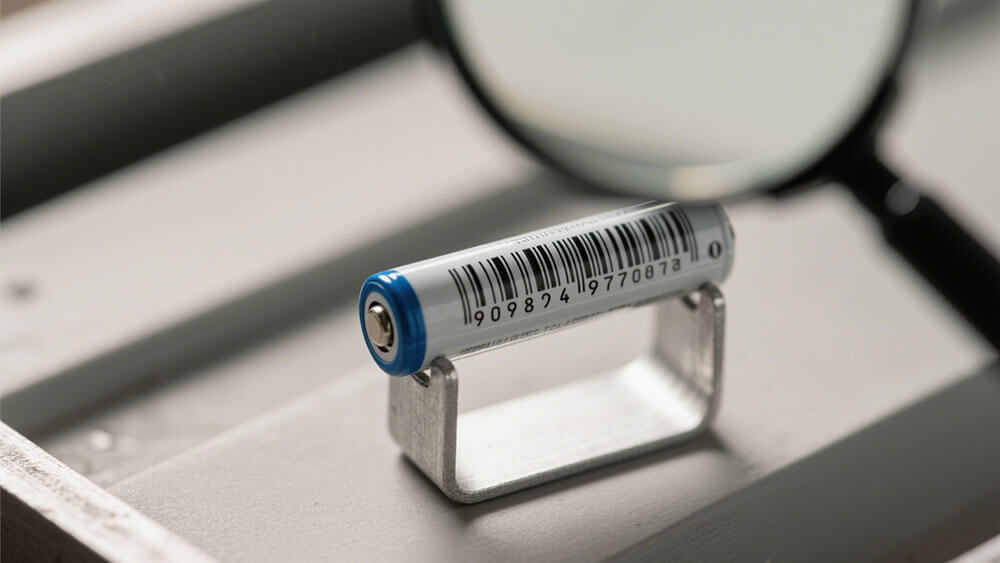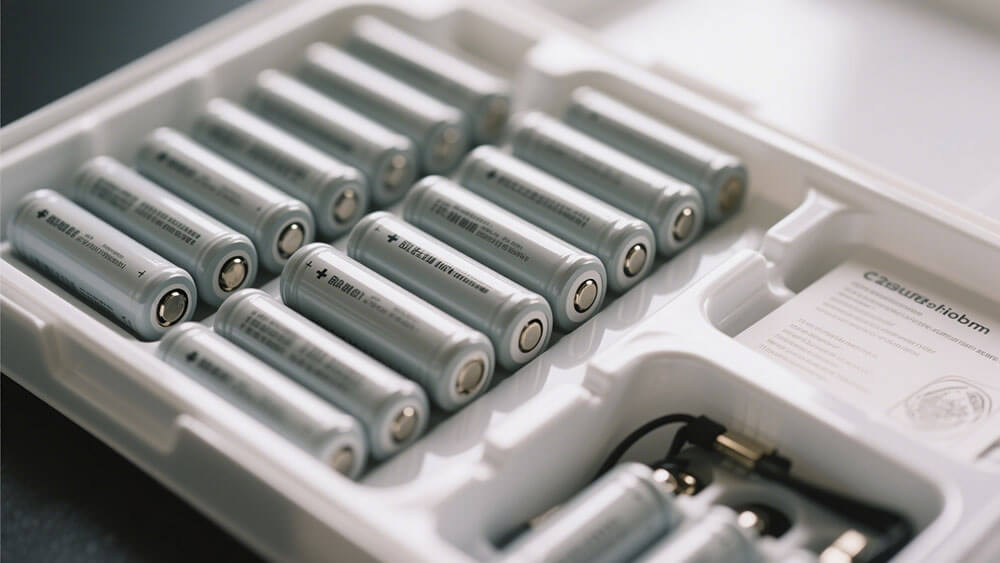
Primary and secondary batteries serve distinct purposes in powering devices. Primary batteries, designed for single-use, deliver energy until depletion, while secondary batteries support multiple cycles through recharging. This fundamental difference between primary and secondary battery technologies impacts business decisions. With the global secondary battery market forecasted to reach $276.83 billion by 2033, understanding their applications can optimize costs, sustainability, and performance across industries like robotics, medical, and infrastructure. Choosing the right battery solution ensures operational efficiency and long-term success.
Key Takeaways
Primary batteries are used once and work well for devices needing little power, like medical tools and emergency gadgets.
Secondary batteries, like lithium-ion ones, can be recharged and save money over time. They are great for things like electric cars and storing energy.
Knowing how batteries differ helps companies save money and be eco-friendly, improving how they work overall.
Part 1: Primary Batteries

1.1 Definition and Characteristics of Primary Batteries
A primary battery is a non-rechargeable energy source designed for single-use applications. These batteries, often referred to as dry cells, are optimized for devices requiring low energy consumption over a limited period. They are characterized by high energy-to-weight and energy-to-volume ratios, making them lightweight and compact. This design ensures convenience and portability, especially for consumer electronics like remote controls and flashlights.
Primary batteries are defined by their chemistry, voltage, and specific energy. For instance, alkaline batteries dominate the market due to their cost-effectiveness and long shelf life. Additionally, they provide instant readiness and reliable performance, which are critical for applications where efficiency cannot be compromised. Before integration into any system, testing these batteries ensures compatibility and safety.
Tip: Understanding the characteristics of primary batteries helps you select the right solution for your business needs, ensuring operational reliability.
1.2 Common Types of Primary Batteries
Several types of primary batteries cater to diverse industrial and consumer needs:
Alkaline Batteries: Known for their affordability and long shelf life, these are ideal for low-drain devices like toys and flashlights.
Lithium Li-FeS2 Batteries: Offering the highest specific energy, they are suitable for moderate-load applications such as digital cameras.
Continuous innovations in alkaline and lithium battery technologies have enhanced energy efficiency while reducing environmental impact. This progress supports the growing demand for portable energy solutions in emerging markets.
Part 2: Advantages and Disadvantages of Primary Batteries

2.1 Advantages of Primary Batteries
Primary batteries offer several benefits that make them indispensable for specific applications. Their long shelf life ensures they remain functional even after extended storage, making them ideal for devices with sporadic use. For instance, emergency flashlights or medical devices like pacemakers rely on this feature to deliver consistent performance when needed. Additionally, their high energy density allows them to store more energy in a compact size, which is crucial for portable devices like cameras or consumer electronics.
Another advantage is their stable voltage output. This characteristic ensures reliable power delivery throughout the battery’s lifespan, which is critical for sensitive equipment. Moreover, their lightweight design enhances the portability of devices, particularly in industries like medical and industrial applications.
Advantage | Description |
|---|---|
Long Shelf Life | Ideal for devices with sporadic use or long storage periods. |
High Energy Density | Provides more energy in a smaller size, beneficial for compact devices. |
Stable Voltage Output | Ensures consistent power delivery throughout the battery’s lifespan, crucial for reliability. |
Lightweight Design | Contributes to the portability of devices like cameras and medical implants. |
2.2 Disadvantages of Primary Batteries
Despite their advantages, primary batteries have limitations that may affect their suitability for certain applications. One major drawback is their inability to recharge, which leads to higher long-term costs for devices with frequent energy demands. Additionally, their self-discharge rate varies by type, with some batteries losing up to 60% of their charge annually. This characteristic makes them less suitable for long-term storage in high-energy applications.
Temperature sensitivity is another concern. Many primary batteries, such as alkaline cells, perform poorly in extreme temperatures, which can compromise their efficiency in outdoor or industrial environments. Furthermore, their energy density, while high compared to some alternatives, remains lower than that of rechargeable options like lithium-ion batteries.
Battery Type | Self-Discharge Rate | Energy Density | Temperature Sensitivity |
|---|---|---|---|
Alkaline Cell | Up to 60% per year | Low | Cannot survive extreme temperatures |
Bobbin-type LiSOCl2 | 0.7% per year | High | Performs poorly in extreme temperatures |
Inferior LiSOCl2 Cell | Up to 3% per year | Moderate | Long-term performance affected by temperature |
Note: For applications requiring frequent energy use or exposure to extreme conditions, secondary batteries like lithium-ion may offer better performance.
Part 3: Secondary Batteries

3.1 Definition and Characteristics of Secondary Batteries
A secondary battery, commonly known as a rechargeable battery, is designed for repeated use through recharging. These batteries store energy chemically and can undergo multiple charge-discharge cycles without significant degradation. Key characteristics include high energy density, long cycle life, and fast charging capabilities, making them ideal for applications requiring consistent and sustainable power. Industry standards such as IEC 60050 and UL 2054 ensure their safety and performance in various environments.
Secondary batteries are essential for businesses prioritizing efficiency and sustainability. Their ability to reduce waste and operational costs makes them a preferred choice for energy storage systems and electric vehicles. For example, lithium-ion batteries, with their high cycle count and low maintenance, have become a cornerstone in modern energy solutions. Their versatility supports diverse applications, from medical devices to robotics and infrastructure.
Note: To explore customized secondary battery solutions tailored to your business needs, visit Large Power’s custom battery solutions.
3.2 Common Types of Secondary Batteries
Several types of secondary batteries dominate the market, each offering unique advantages:
Battery Type | Characteristics | Applications |
|---|---|---|
Lead Acid | Rugged, low specific energy, limited cycle count, economically priced | Wheelchairs, golf cars, emergency lighting, UPS |
Nickel-cadmium (NiCd) | Long service life, high discharge current, rugged, allows ultra-fast charging | Power tools, medical devices, aviation, UPS |
Nickel-metal-hydride (NiMH) | Higher specific energy, mild toxic metals | Medical instruments, hybrid cars, consumer use |
Lithium-ion (Li-ion) | High cycle count, low maintenance, more expensive, requires protection circuit | Replacing lead and nickel-based batteries in many applications |
Among these, lithium-ion batteries stand out due to their superior energy density and cycle life. They are widely used in industries like robotics and consumer electronics, where reliability and performance are critical.
3.3 Applications of Secondary Batteries in Business
Secondary batteries play a pivotal role in modern business operations. Their reusability and efficiency make them indispensable for industries aiming to optimize costs and reduce environmental impact. Key applications include:
Energy storage systems: Secondary batteries provide flexibility in electricity markets, supporting renewable energy integration and grid stability.
Electric vehicles (EVs): Reused EV batteries minimize e-waste and offer cost-effective energy storage solutions.
Medical devices: Rechargeable batteries power critical equipment like portable monitors and infusion pumps.
Robotics: Secondary batteries enhance the performance of automated systems in manufacturing and logistics.
Infrastructure: They support transportation systems and backup power for critical infrastructure.
Research highlights the economic and environmental benefits of second-use batteries. For instance, studies by Tang and Wang (2023) demonstrate their competitive nature in energy markets. Businesses leveraging these solutions can achieve sustainability goals while maintaining operational efficiency.
Tip: Learn more about sustainable battery solutions at Large Power’s sustainability page.
Part 4: Advantages and Disadvantages of Secondary Batteries

4.1 Advantages of Secondary Batteries
Secondary battery advantages make them a preferred choice for businesses seeking sustainable and cost-effective energy solutions. Their reusability significantly reduces waste, aligning with global sustainability goals. Unlike primary batteries, secondary batteries can undergo hundreds or even thousands of charge-discharge cycles, depending on the chemistry. For instance, lithium-ion batteries, with a cycle life of 500–2,000 cycles, offer exceptional longevity and reliability. This durability minimizes replacement costs and ensures consistent performance in applications like robotics and medical devices.
Another key advantage is their high energy density. Secondary batteries, particularly lithium-ion variants, store more energy per unit weight compared to older technologies like lead-acid batteries. This feature makes them ideal for portable devices and electric vehicles, where weight and space are critical considerations. Additionally, advancements in battery management systems (BMS) enhance their safety and efficiency, ensuring optimal performance across diverse industries.
Tip: If your business prioritizes sustainability and long-term cost savings, secondary batteries are an excellent investment. Explore customized battery solutions to find the right fit for your needs.
4.2 Disadvantages of Secondary Batteries
Despite their benefits, secondary batteries have limitations that may impact their suitability for certain applications. One major drawback is their reliance on critical raw materials like lithium and cobalt. The extraction of these materials poses environmental challenges and raises ethical concerns. Additionally, current recycling methods for lithium-ion batteries remain inadequate, hindering the development of a circular economy.
Secondary batteries also face safety issues, including the risk of thermal runaway, which can lead to fires or explosions. Their flammable electrolytes and susceptibility to short circuits require careful handling and robust safety measures. Furthermore, their energy density, while high, still falls short compared to fossil fuels, limiting their efficiency in some high-energy applications.
Disadvantage | Description |
|---|---|
Reliance on Critical Raw Materials | Environmental impacts associated with the extraction of materials like lithium and cobalt. |
Poor Recyclability | Current recycling methods are inadequate for supporting a circular economy for LiBs. |
Inflammability | Risk of fires or explosions due to flammable electrolytes and potential short circuits. |
Low Energy Density | LiBs store less energy per unit compared to fossil fuels, limiting their efficiency. |
Short Lifecycle | Limited charge and discharge cycles lead to reduced battery life and more frequent replacements. |
Environmental Impact of Disposal | Challenges in end-of-life management and waste disposal for first-generation LiBs. |
Safety Issues | Susceptibility to thermal runaway and other safety hazards during use. |
High Cost | The expense of materials like lithium and cobalt hinders widespread adoption of LiBs. |
Note: To mitigate these challenges, consider exploring advanced technologies like solid-state batteries or LiFePO4 lithium batteries, which offer improved safety and recyclability. Learn more about sustainable battery solutions here.
Part 5: Detailed Comparison of Primary and Secondary Batteries

5.1 Reusability and Rechargeability
When considering battery solutions, understanding the reusability and rechargeability of primary and secondary batteries is crucial. Primary batteries are designed for single use and disposal, making them suitable for applications where immediate power is needed without the possibility of recharging. In contrast, secondary batteries, also known as rechargeable batteries, can be recharged and reused multiple times. This feature makes them more cost-effective in the long term, especially for devices requiring frequent power cycles.
Primary batteries are designed for single use and disposal.
Secondary batteries can be recharged and reused, making them more cost-effective in the long term.
The active materials in secondary batteries are reversible, unlike those in primary batteries.
5.2 Chemical Reactions and Efficiency
The chemical reactions within batteries determine their efficiency and suitability for various applications. Primary batteries generate energy through a one-time chemical reaction, which limits their lifespan. Secondary batteries, however, undergo reversible reactions, allowing them to be recharged. This capability enhances their efficiency and makes them ideal for applications requiring sustained power.
5.3 Longevity and Performance
The longevity and performance of batteries are critical factors in selecting the right type for your needs. Primary batteries offer a longer shelf life, making them suitable for devices that require consistent power over a limited time. However, their service lifespan is shorter compared to secondary batteries, which can be recharged and used multiple times.
Characteristic | Primary Batteries | Secondary Batteries |
|---|---|---|
Rechargeability | Non-rechargeable, designed for single-use | Rechargeable, can be used multiple times |
Energy Density | Generally have a higher initial energy density | Slightly lower initial energy density |
Lifespan | Longer shelf life, but shorter service lifespan | Longer service lifespan, varies by chemical composition and application |
Application | Used in devices needing consistent power for a limited time | Preferred for devices requiring frequent use and convenient recharging |
Examples | Zinc-carbon, alkaline, lithium-silicon | Lead-acid, lithium-ion, nickel-cadmium |
5.4 Cost and Economic Considerations
Cost is a significant factor when choosing between primary and secondary batteries. Primary batteries are cheaper upfront but can become costly over time due to frequent replacements. Secondary batteries, while having a higher initial cost, offer long-term savings through their reusability. This economic advantage makes them a preferred choice for businesses looking to optimize operational costs.
Feature | Primary Batteries | Secondary Batteries |
|---|---|---|
Reusability | Designed for single use, cannot be recharged. | Can be recharged and reused multiple times. |
Cost | Cheaper upfront but costly over time due to replacements. | Higher initial cost but long-term savings through reuse. |
5.5 Environmental Impact and Sustainability
The environmental impact of battery use is a growing concern for businesses aiming for sustainability. Primary batteries contribute to waste after single use, posing environmental challenges. In contrast, secondary batteries reduce waste by allowing reuse, making them more environmentally friendly. Their ability to be recharged and reused aligns with global sustainability goals, offering a greener alternative for energy storage.
Note: For businesses prioritizing sustainability, exploring advanced technologies like solid-state batteries or LiFePO4 lithium batteries can offer improved safety and recyclability.
Understanding the differences between primary and secondary batteries is essential for optimizing business operations. Primary batteries suit low-energy, single-use applications, while secondary batteries, like lithium-ion batteries, excel in reusable, high-demand scenarios. For long-term efficiency and sustainability, consider customized lithium battery solutions from Large Power tailored to your industry needs.
FAQ
1. What is the main difference between primary and secondary batteries?
Primary batteries are single-use and non-rechargeable, while secondary batteries can be recharged multiple times. Secondary batteries, like lithium-ion batteries, offer long-term cost savings.
Tip: For customized lithium-ion battery solutions, visit Large Power.
2. Why are lithium-ion batteries preferred for industrial applications?
Lithium-ion batteries provide high energy density, long cycle life, and low maintenance. These features make them ideal for industrial systems requiring reliable and efficient power.
Note: Learn more about lithium-ion batteries here.
3. How do secondary batteries support sustainability goals?
Secondary batteries reduce waste by enabling reuse and minimizing disposal. Their recyclability and efficiency align with global sustainability initiatives.
Learn More: Explore sustainable battery solutions at Large Power.




